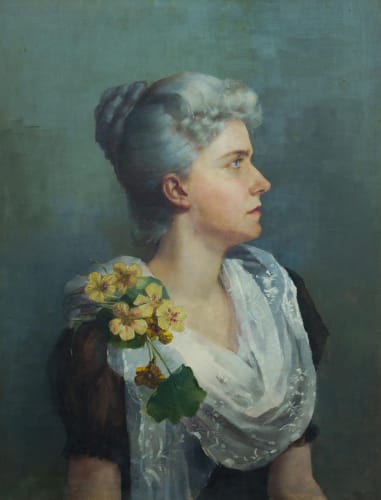Miss Stephens holds a distinguished position in art circles. That fact is proved by her election as the first lady member of the Council of the Art Society.
Ethel Anna Stephens was born in Sydney to William Stephens, the headmaster of Sydney Grammar School and Anna Louise (née Daniell) in 1864. She began showcasing her artistic talents with the Royal Art Society of NSW in 1883 and seven of her drawings were featured in the 'work of private classes held in Sydney Technical College Rooms’ at the 1886 Colonial and Indian Exhibition in London. In the same year, she would become the first pupil of Julian Ashton who founded the influential Julian Ashton School.
In 1888, she exhibited 'some watercolour flowers’ at the Women’s Industries Exhibition in Sydney, and in 1890, she won first and second prizes for life-size studies of heads at the Art Gallery of New South Wales. Two years later, in 1892, she became the first woman elected to the Council of the Art Society of NSW and was re-elected in 1894. Stephens was also a founding member of the Society of Artists and exhibited with them, showcasing her work in the 1901 Commonwealth Exhibition. Despite facing marginalization in art society exhibitions due to her gender and preferred subjects, particularly flower painting, she actively promoted all-women exhibitions.
In 1905, Stephens initiated 'Five Lady Artists’ at Bradley’s Art Gallery in Sydney, featuring her cousin Alice Norton, Emily Meston, and Aline and Edith Cusack. These artists later became inaugural members of the Sydney Society of Women Painters, founded in 1910. Stephens remained an active member of this society until 1934, contributing as president and on its selection committees. She resigned when the society transitioned into the more commercial Women’s Industrial Arts Society. Additionally, she was an early member of the Society of Arts & Crafts of NSW, founded in 1906.
Following her father’s death in 1891, Stephens began teaching art, holding painting classes in her studio from at least 1900. Her artwork gained recognition, enabling her to build a home in Vaucluse with a studio in the 1920s. She undertook several trips abroad, including London and Paris in 1920-23, where she studied at La Grande Chaumière and exhibited in the Old Salon. Stephens frequently delivered talks on art, emphasizing the importance of tradition based on her training and background.
